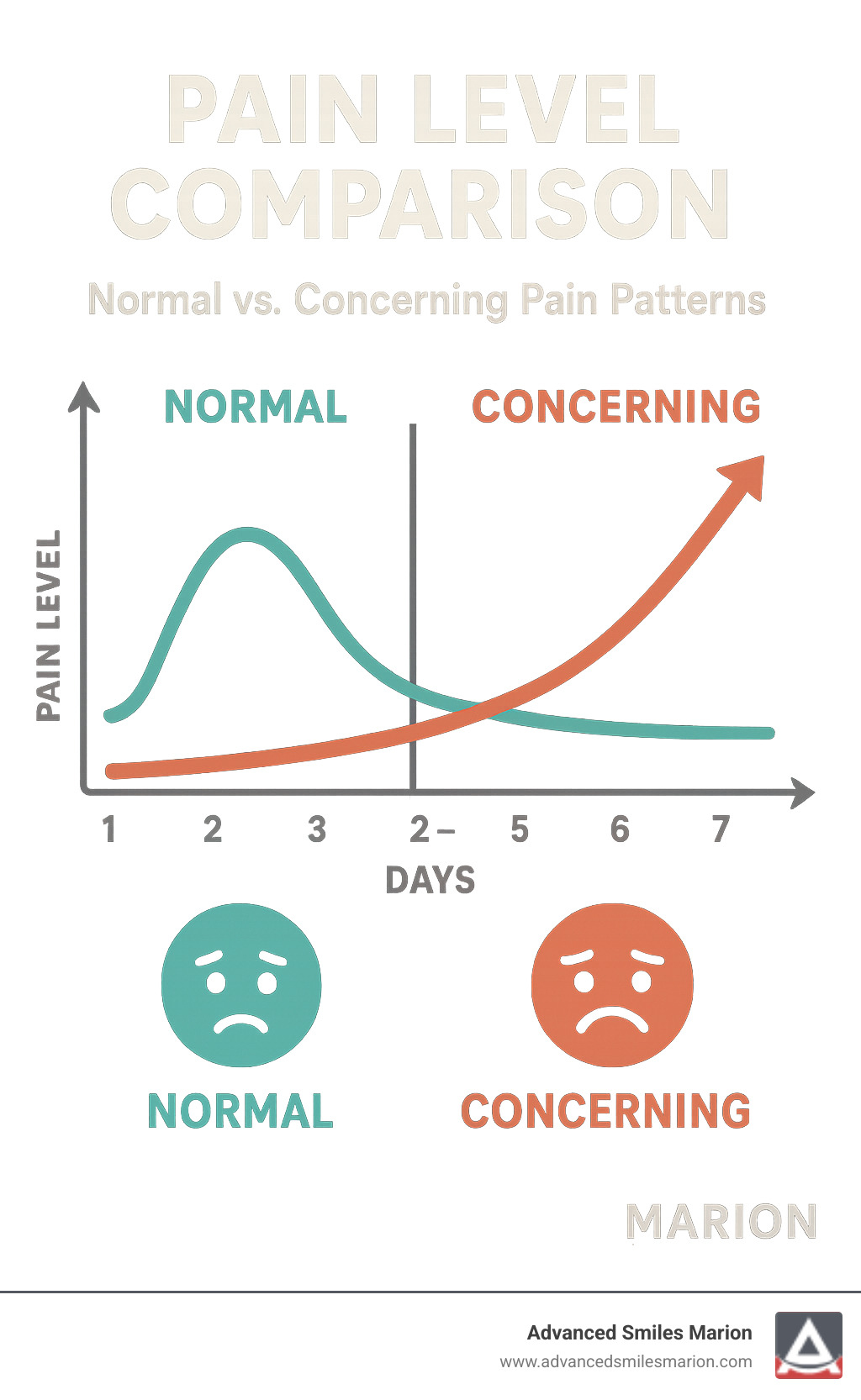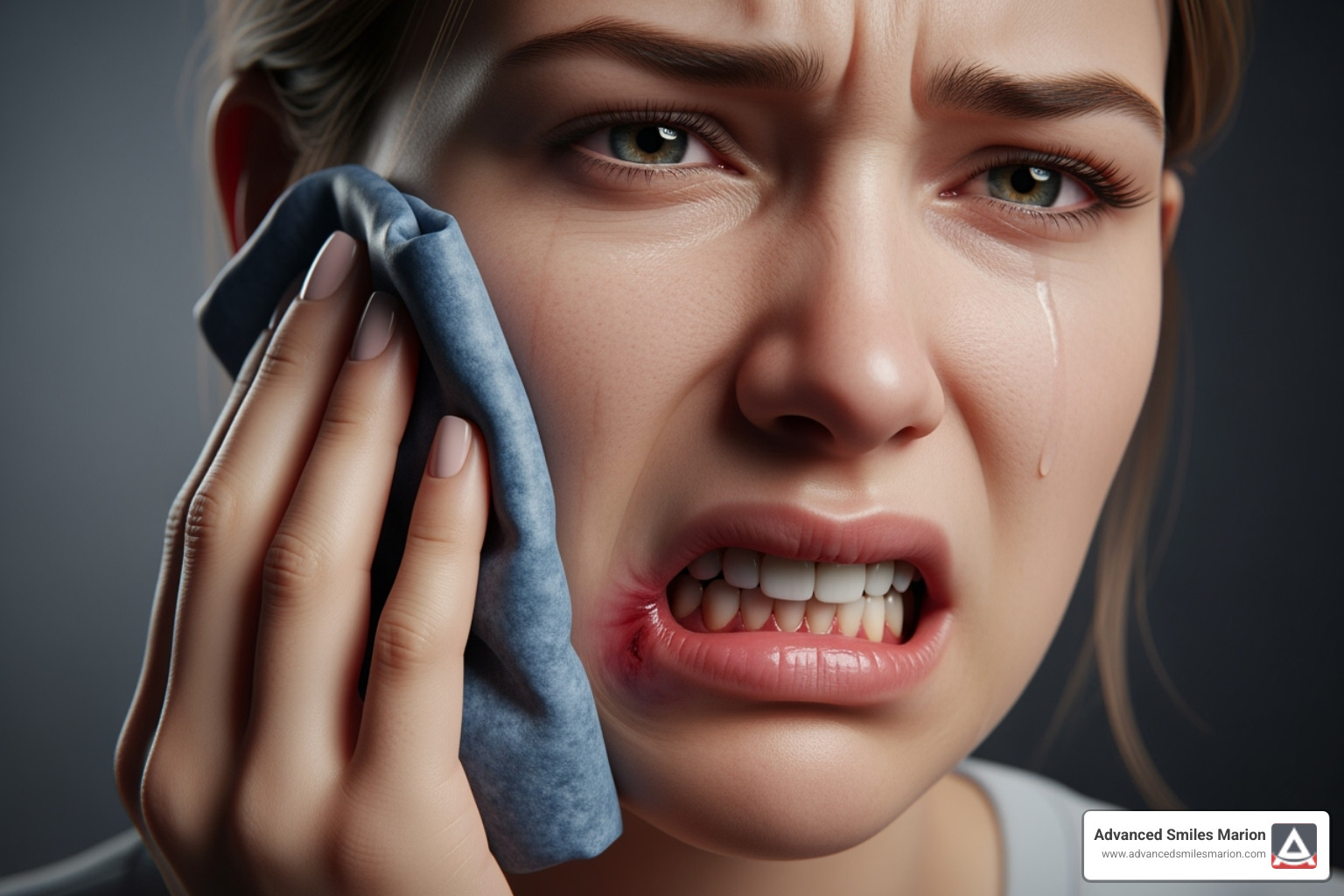What to Expect on Your Wisdom Teeth Recovery Journey
The hours and days after surgery can feel uncertain, but a clear road map makes all the difference. In this guide you will learn why the worst day of pain after wisdom tooth extraction usually arrives around day three, what a normal healing timeline looks like, and how to keep discomfort under control while your mouth mends.
For anyone unfamiliar with the procedure itself, here is a concise background on impacted wisdom teeth. Armed with that context, let’s dive into the recovery process and show you how the highly educated and involved dentists at Advanced Smiles Marion help patients in Marion, OH move from surgery to relief as smoothly as possible.
The Day-by-Day Healing Timeline: From Surgery to Relief
This section outlines the typical progression of symptoms so you can recognise what is normal at each stage of your Wisdom Tooth Extraction Recovery.
Day 1: The Aftermath of Surgery
As the anesthesia fades you will notice a dull ache rather than sharp pain. Light oozing is expected—bite gently on fresh gauze and replace it as needed. Skip housework, stick with soft foods like yogurt or lukewarm soup, and sip water without a straw. Rest really is medicine on day 1. For more tips, see your First Night After Tooth Extraction.
Days 2-3: Navigating the Worst Day of Pain After Wisdom Tooth Extraction
Inflammation peaks 48-72 hours after surgery, so expect swelling, jaw stiffness, and a throbbing sensation that pulses with your heartbeat. This isn’t a setback—it is your immune system delivering healing cells to the area. Keep ice packs in rotation (15 minutes on, 15 minutes off) and sleep with your head liftd. Detailed advice is in our guide to wisdom teeth recovery.
Days 4-7: Turning the Corner Toward Healing
Discomfort starts to ease as swelling diminishes and pain shifts to a mild soreness. You can usually open your mouth wider and add foods like scrambled eggs, pasta, or mashed potatoes to your menu. Begin gentle warm-salt-water rinses (½ tsp salt in a cup of warm water) after meals. Learn more about healing speed in How Long Does It Take For Wisdom Teeth To Heal.
Week 2 and Beyond: Nearing Full Recovery
Most patients feel minimal discomfort by the second week. New tissue continues filling the socket, and regular activities—including work or school—can usually resume. Keep very hard or crunchy foods out of your diet until our team confirms the area is fully stable at your follow-up visit.
Factors That Influence Your Recovery Experience

While everyone experiences some discomfort after wisdom tooth extraction, the intensity of your worst day of pain after wisdom tooth extraction can vary dramatically from person to person. Understanding what influences your recovery helps set realistic expectations and can even help you prepare for a smoother healing process.
The complexity of your extraction plays the biggest role in determining your pain level. If your wisdom teeth were fully erupted and came out easily, you'll likely have a much gentler recovery than someone whose teeth were deeply impacted. When teeth are buried under gum tissue or trapped beneath bone, the surgical process becomes more involved, requiring more tissue manipulation and sometimes bone removal.
How many teeth you have removed also makes a significant difference. Having all four wisdom teeth extracted at once typically means more swelling and discomfort than a single extraction. However, many patients choose to tackle all four at once to avoid multiple recovery periods - and honestly, that makes a lot of sense when you think about it.
Your age matters more than you might expect. Younger patients in their late teens and early twenties generally bounce back faster and experience less severe pain. Their bodies heal more quickly, and the roots of their wisdom teeth are often less developed, making extraction easier. If you're in your thirties or beyond, don't be surprised if your recovery takes a bit longer.
Your overall health significantly impacts how your body handles the healing process. Conditions like diabetes can slow healing and potentially make your recovery more challenging. If you have any chronic health conditions, it's important to discuss them with our dentists so we can adjust your care plan accordingly.
The factor that makes the biggest difference in your recovery experience is how well you follow your post-operative instructions. Patients who rest properly, eat the right foods, and avoid activities that could disrupt healing consistently report easier recoveries. It's really that simple - your body knows how to heal, but you need to give it the right conditions to do its job.
Smoking and alcohol use can turn a manageable recovery into a much more difficult one. Both habits significantly impair your body's ability to heal and dramatically increase your risk of developing dry socket, a painful complication that can extend your recovery by days or even weeks.
The highly educated and involved dentists at Advanced Smiles Marion take all these factors into account when planning your extraction and recovery. We provide personalized post-operative guidance based on your specific situation, helping you steer your recovery with confidence.
Information on Tooth Extractions.
Proactive Pain Management: Your Toolkit for a Smoother Recovery
A simple, consistent plan can make the worst day of pain after wisdom tooth extraction far more manageable.
Medication and Pain Relief
• Take prescribed pain medicine exactly on schedule—set phone reminders so you stay ahead of discomfort.
• Ibuprofen 600–800 mg every 6–8 hours reduces both pain and swelling. Acetaminophen can be alternated with ibuprofen for steady coverage. Always follow label instructions or our written guidance.
Taming Swelling and Discomfort
• Apply an ice pack for 15-20 minutes, then rest the skin for the same amount of time, during the first 48 hours.
• Sleep with an extra pillow or in a recliner so gravity helps fluid drain instead of pooling in your cheeks.
• Avoid strenuous activity, heavy lifting, and bending over—each can increase bleeding and swelling.
Essential Dietary and Oral-Hygiene Practices
Approved soft foods include yogurt, smoothies (no straws), mashed potatoes, soup, scrambled eggs, applesauce, pudding, and protein shakes. Drink plenty of water, but skip carbonated or alcoholic beverages. Begin gentle salt-water rinses 24 hours after surgery and brush carefully, steering clear of the surgical sites. More details are in What to know about recovery time.
Understanding Complications and When to Call Your Dentist
While most recoveries are smooth, it's crucial to recognize warning signs that might indicate complications affecting your worst day of pain after wisdom tooth extraction.
Recognizing the Signs of Dry Socket
Dry socket sounds scary, but understanding what it is helps you spot it early. This condition happens when the protective blood clot in your extraction socket gets dislodged or dissolves too soon - kind of like losing nature's bandage before the wound is ready.
What makes dry socket different from normal healing pain is timing and intensity. While your worst day of pain after wisdom tooth extraction typically peaks around days 2-3 and then improves, dry socket pain usually starts 3-5 days after surgery and feels much more severe than anything you've experienced so far.
The telltale signs are hard to miss. You'll notice severe, throbbing pain that doesn't respond to your pain medication like it should. Looking in the mirror, you might actually see visible bone in the socket where the blood clot should be. There's often a bad taste or foul smell coming from the extraction site that makes you want to rinse constantly.
What really sets dry socket apart is how the pain radiates. Instead of staying localized to your jaw, it can shoot up to your ear, eye, temple, or down your neck. It's your body's way of saying "something's not right here."
If dry socket develops, it can turn what should be your recovery days into an extended worst day of pain after wisdom tooth extraction. Instead of feeling better after day 3, you might find yourself dealing with intense pain that seems to come out of nowhere.
Watching for Infection

Infection is another complication that can completely derail your recovery timeline. The tricky thing about infection is that it often develops just when you think you're turning the corner.
Pay attention to pain that gets worse instead of better after day 4. Normal healing follows a predictable pattern - peak pain around days 2-3, then gradual improvement. If your pain suddenly spikes or refuses to improve after you've passed the typical worst days, your body might be fighting an infection.
Swelling that won't quit is another red flag. While some swelling is normal for the first few days, it should start going down by day 4 or 5. If your cheek looks like you're storing nuts for winter and it's not getting better, that's cause for concern.
Watch for pus or unusual discharge from the extraction site. A little bit of clear or slightly bloody fluid is normal, but thick, yellowish, or foul-smelling discharge suggests bacteria have moved in where they don't belong.
Fever above 101°F is your body's alarm system going off. Combined with other symptoms, it's a clear sign that something more serious than normal healing is happening. Persistent bad breath or a foul taste that doesn't improve with gentle salt water rinses can also indicate infection taking hold.
The most frustrating part about infection is that it doesn't respond to your usual pain management routine. You might find yourself taking medication on schedule but still feeling miserable.
When to Seek Emergency Dental Care
Some situations simply can't wait for your next scheduled appointment. Excessive bleeding that won't stop with gentle pressure needs immediate attention. We're not talking about the light oozing that's normal for the first day or two - this is bleeding that soaks through gauze quickly and consistently.
Difficulty breathing or swallowing is serious business. While some jaw stiffness is normal, if you're having trouble with basic functions like breathing or swallowing, don't wait to get help.
Severe pain that isn't managed by prescribed medication when taken as directed is another emergency situation. If you're following your pain management plan perfectly and still experiencing unbearable discomfort, something needs immediate attention.
High fever over 101°F accompanied by other symptoms like severe pain, excessive swelling, or difficulty swallowing requires prompt care. Your body is working overtime to fight something serious.
At Advanced Smiles Marion, our highly educated and involved dentists understand that dental emergencies don't follow business hours. We can often provide same-day care for urgent situations, ensuring you get the help you need when complications arise during your recovery.
Contact our Emergency Dentist in Marion Ohio.
Frequently Asked Questions About Wisdom Tooth Pain
Why is the pain worse on day 3 than day 1?
The worst day of pain after wisdom tooth extraction typically occurs on day 2 or 3, and there's a fascinating scientific reason behind this timing that has nothing to do with how well your surgery went.
On day 1, you're still riding the wave of residual anesthesia, and your body hasn't yet fully recognized what happened. Think of it as the calm before the storm. Your immune system is just beginning to assess the situation and mobilize its healing resources.
By days 2-3, however, your body's natural inflammatory response kicks into high gear. This is actually a good thing - it means your immune system is working exactly as it should. Your body floods the surgical site with healing cells, increased blood flow, and protective fluids. While this inflammatory response is essential for proper healing, it creates significant swelling that puts pressure on surrounding tissues and nerves.
The body's natural inflammatory response to the surgical trauma peaks around 48-72 hours post-procedure, causing maximum swelling and nerve sensitivity during this time before it begins to subside. This is why many patients describe day 3 as feeling like their face is "pulsing" or experiencing a deep, throbbing sensation that seems to match their heartbeat.
Once this peak passes, the inflammatory response begins to calm down, and you'll notice the pain gradually decreasing each day. Understanding this timeline helps you realize that the intensity of pain isn't a sign of complications - it's your body doing exactly what it needs to do to heal properly.
Can I speed up the healing process?
While you can't magically fast-forward through recovery, you absolutely can give your body the best possible conditions to heal efficiently and potentially reduce the severity of your worst day of pain after wisdom tooth extraction.
Following post-operative instructions religiously is your most powerful tool. Every instruction we give you is based on research and experience about what promotes fastest healing. When patients skip steps or think "just this once won't hurt," they often end up with longer, more painful recoveries.
Rest is not optional - it's medicine. Your body needs to redirect energy toward healing rather than keeping up with your normal activities. Plan to take it easy for at least the first 3-5 days, and don't feel guilty about it. Getting plenty of rest is literally part of your treatment plan.
Proper nutrition gives your body the building blocks it needs for tissue repair. Focus on protein-rich soft foods and options high in vitamins C and A. Staying hydrated supports all of your body's healing processes and helps prevent complications.
Avoiding smoking or using straws cannot be overstated. These activities can dislodge blood clots and significantly set back your healing. The same goes for alcohol, which impairs your immune system's ability to do its job.
Even gentle movement, like short walks around your house, can promote circulation and healing without overtaxing your system. The key is finding the balance between rest and gentle activity.
Find more Tooth Extraction Recovery Tips.
What does normal healing pain feel like?
Understanding what normal pain feels like versus concerning pain can save you a lot of anxiety and help you know when to seek help. Many patients worry that their pain level means something is wrong, when in fact they're experiencing exactly what we'd expect.
Normal healing pain is typically a dull, manageable ache or throb that peaks around day 2 or 3 and then gradually decreases. It should respond reasonably well to the pain medication we've prescribed or recommended. Many patients describe it as a deep, constant ache that's definitely uncomfortable but not unbearable.
This normal pain usually stays localized to the extraction site and immediately surrounding area. You might feel it extending to your jaw, ear, or temple on the same side, but it shouldn't be spreading to other parts of your head or body.
The key characteristic of normal pain is that it follows the expected timeline - getting worse for the first few days, then steadily improving. Even if it's intense during the peak period, you should notice gradual improvement day by day after the worst day passes.
Concerning pain tells a different story. It's often sharp and severe rather than dull, and it doesn't respond well to medication. Pain that suddenly worsens after initially improving, or severe throbbing that begins 3-5 days after extraction, could signal complications like dry socket.
Pain accompanied by fever, pus, or foul odor suggests possible infection and needs immediate attention. Similarly, if your pain is getting progressively worse rather than better after day 4, that's not part of the normal healing process.

At Advanced Smiles Marion, our highly educated and involved dentists want you to feel confident about what you're experiencing. If you're ever unsure whether your pain is normal or concerning, don't hesitate to call us. We'd rather reassure you that everything is progressing normally than have you worry unnecessarily or miss signs of a complication that needs attention.
Your Path to a Pain-Free Smile After Extraction
Navigating the recovery from a wisdom tooth extraction can feel overwhelming, especially when you're bracing for the worst day of pain after wisdom tooth extraction. But here's the reassuring truth: this intense discomfort is temporary, manageable, and completely normal.
The peak pain you experience on days 2-3 isn't a sign that something has gone wrong - it's actually proof that your body is working hard to heal itself. Understanding this timeline and following your aftercare instructions carefully makes all the difference in how smoothly your recovery unfolds.
Recovery is a journey, not a destination. While the worst day of pain after wisdom tooth extraction can be challenging, it's just one phase in your path to better oral health. Most patients are amazed at how quickly they turn the corner once they pass that peak inflammation period.
The highly educated and involved dentists at Advanced Smiles Marion understand that every patient's recovery experience is unique. We're committed to ensuring your comfort throughout every procedure, providing detailed post-operative guidance custom to your specific needs. Our team's extensive training means you're never alone in managing your dental health journey - we're here to support you every step of the way.
Whether you have questions about your current recovery or are planning future dental procedures, we're here to help you achieve a healthy, Pain Free Smile.
Our comprehensive approach to dental care extends far beyond extractions. Explore our advanced dentistry services including Invisalign for discreet orthodontic treatment, TMJ Pain solutions featuring innovative laser treatments, Teeth Whitening for a brighter smile, Tooth Bonding for cosmetic improvements, Dental Implants (endosteal implants), Veneers for smile makeovers, Crowns for tooth restoration, Root Canal therapy, Digital Dentures with advanced technology, Oral Hygiene & Wellness checkups, and Botox for therapeutic and cosmetic applications.
We're particularly excited about our cutting-edge laser treatments for TMJ pain relief, canker sore healing, and periodontal disease treatment. These represent the latest advances in comfortable, effective dental care that can make your treatment experience significantly more pleasant.
For families and individuals without dental insurance, our Dental Wellness Plan makes quality care accessible and affordable. This plan now includes 2 fluoride treatments per year, helping you get the yearly dental care you need at a discounted price right here in Marion, OH.
When dental emergencies strike, we're ready to help. We offer emergency dental treatments and can often see you the same day, because we know that dental pain doesn't wait for convenient timing.
While the worst day of pain after wisdom tooth extraction can feel overwhelming in the moment, it's a temporary phase in your journey to better oral health. With proper care, patience, and our professional guidance, you'll soon be enjoying the benefits of a healthier, more comfortable smile. The discomfort you're experiencing today is paving the way for years of improved oral health ahead.

Panel 5: Modern Marion
Bright, playful colors bring contemporary Marion to life. The cardinal, with a proud stance, watches over downtown Marion, a testament to the city's vibrant culture, celebrations, and communal spirit.

Get in touch
Have any questions? Want to learn more?

